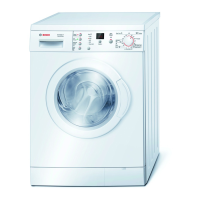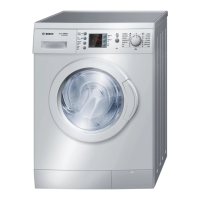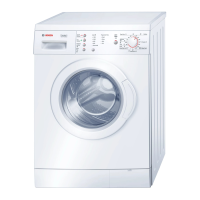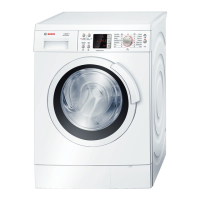8
Safety instructions
– Read th e Instruction Manual and Installation Instructions and all other information enclosed with the washing
machine and use the machine accordingly.
– Retai n the documents for subsequent use.
Risk of electric shock – Never pull o n the cable to disconnect the mains plug.
– Only i nsert/pull out the mains plug with dry hands.
Danger to life For worn-out appliances:
– Disco nnect the mains plug.
– Cut through the mains cable and remove complete with plug.
– Destro y the lock on the washing machine door. This will prevent children from
locking themselves in and risking their lives.
Danger of suffocation – Keep packaging, fi lm and packaging parts out of the reach of children.
Risk of poisoning – Keep detergents and care products out of the reach of children.
Risk of explosion – Items of laun dry pretreated with cleaning agents containing solvents, e.g. stain
remover/cleaning solvent may cause an explosion after bein g loaded into the
washing machine.
Rinse items of laundry thoroughly by hand before hand.
Risk of injury – The washing machine door can beco me very hot.
– Be ca reful when draining hot detergent solution.
– Do no t climb onto the washing machine.
– Do no t lean on the open washing machine door.
– Do no t reach into the drum if it is still rotating.
Consumption values depending on model
Programme Load Power *** Water***
Programme
duration***
Cottons LF 30 °C* 8 kg 0.3 5 kWh 76 l 2:20 h
Cottons LF 40 °C* 8 kg 0.9 7 kWh 76 l 2:30 h
Cottons LF 60 °C* 8 kg 1.3 6 kWh 76 l 2:40 h
Cottons LF 90 °C 8 kg 2.3 4 kWh 87 l 2:30 h
Easy-Care I 40 °C* 3.5 kg 0.55 kWh 55 l 1:43 h
Mixed Load / 40 °C*
3.5 kg 0.47 kWh 49 l 1:01 h
Delicate/Silk 30 °C 2 kg 0.14 kWh 35 l 0:41 h
Wool : 30 °C 2 kg 0.1 6 kWh 40 l 0:40 h
* Programme s etting for testing in accordance with applicable standard EN60456.
Note on comparative tests: When using the test programmes , wash the specified load using the maximum spin speed.
Programme Additional function Load
Annual energy
consumption
Annual water
consumption
Cottons LF 40/60 °C
ĈEco Perfect**
8/4 kg 189 kWh 10500 l
** Pro gramme setting for testing and energy labelling in accordance with EU directive 20 10/30/EU with cold water (15 °C).
*** The values deviate from the indicated values depending on water p ressure, hardness, and inlet temperature, ambient
temperature, type, amount and soiling of the laundry, detergent u sed, fluctuations in the power supply and selected
additional functions.
9
Important information
Before washing for the first time
Do not put any laundry in the machine. Turn th e tap on. Pour the following into compartment II:
– approx. 1 litre water
– detergen t (amount to be used according to the manufacturer's instructions for lig ht soiling and
according to water hardness)
Turn the programme selector to Easy-Care I 60 °C and press $Start/Reload.
At the end of the programme, turn the programm e selector to Off.
Protecting the lau ndry and the machine
– When mea suring detergent, care products and cleaning agents, follow the manufa cturer's instructions.
– Em pty pockets.
– Look o ut for metal items (paperclips, etc.).
– Wash delicates in a laundry bag (tights, curtains, underwired bras).
– Fasten zips, do up any buttons.
– Brush s and out of pockets and collars.
– Remo ve curtain fittings or place in the laundry bag.
Loading laun dry
Insert items of laundry of varying sizes.
Take care not to trap items of laundry between the washing machine door and the rubber seal.
Laundry with varying degrees of soiling
Wash new items of clothing separately.
light
No prewash. If required, select the additional ĉS peed Perfect function.
Pretreat any stains as necessary.
heavy Do not load as much laundry. Select the programme with Pr ewash.
Soaking Load laundry of the same colour.
Pour soaking agent/detergent into compart ment II in accordance with the manufacturer's instructions.
Set the programme selector to Cottons LF 30 °C and select $Start/Reload.
After approx. 10 minutes, press $ Start/Reload to stop the programme. A fter the required soaking time,
press $Start/Reload again to contin ue the programme, or change the programme.
Starching Laundry must not be treated with fabric softener
Starching is possible in all wash programmes if liquid starch is used. Pour starch into the ~ fabric softener compart-
ment in accordance with the manufacturer's ins tructions (rinse first if necessary).
Dyeing/bleaching
Dye should only be used in normal household quantities. Salt may damage stainless steel. Always follow the dye
manufacturer's instructions. Do not use the washing machine for bleaching clothes.
10
Insert for liquid detergent depending on model
Position the insert for dispensing liquid deterg ent:
– Remove the detergent drawer completely apage 10.
– Slide the insert forwards.
Do not use the insert (slide upwards):
– For gel-ty pe detergents and washing powder,
– for programmes with + Prewash 7or (Finished in) option
Care
ʑ
Machine housing, c ontrol panel
– Remo ve detergent residue immediately.
– Wipe with a soft, damp cloth.
– Do no t clean with a jet of water.
Cleaning the deterg ent drawer ...
... if it contains detergent or fabric softener resid ues.
1. Pull out, press insert down, remove drawer com pletely.
2. To remove the insert: press the insert upwards from below with your finger.
3. Clean the detergent dispenser tray and insert wi th water and a brush and dry it.
4. Fit the insert and lock it in place (push the cy linder onto the guide pin).
5. Push in the detergent drawer.
Leave the detergent drawer open so that any resi dual water can evaporate.
ʑ
Drum
Leave the washing machine door open so tha t the drum can dry out.
Use chlorine-free cleaning agent, not steel wool .
ʑ
Descaling Ensure there is no laundry in the mac hine
This should not be necessary if the correct detergent dosage has been used. If it is necessary, however, proceed
according to the descaling agent manufactur er's instructions. Suitable descalers can be obtained via our website or
from our after-sales service (apage 13).
Instructions in the display panel depending on mode l
,flashing Close the washing machine door properly; laundry may be caug ht.
§:³Å, ÉOpen the tap completely, supply hose kinked or tra pped; Clean the filter apage 11 ,
water pressure too low.
§:³µDetergent solution pum p blocked; Clean the detergent solution pump apage 11.
Drain hose/waste pipe blocked; Clean the drain hos e on the siphon apag e 11.
§: ´Water in the base tub, appliance l eaking. Call the after-sales service.
Other displays Switch off the appliance, wait for 5 seconds and switch it ba ck on. If the display appears again,
call the after-sales service apage 13.
– Risk of electric shock. Disconnect the mains plug.
– Risk of explosion. No solvents.
11
Information about blockages
Detergent soluti on pump
Turn the programme selector to Off and disconnect the main s plug.
1. Open and remove the service flap.
2. Take the drain hose out of the retainer.
Remove the sealing cap, allow the detergent soluti on to flow out.
Push the sealing cap back on.
3. Unscrew the pump cover carefully (residual water).
4. Clean the interior, pump cover thread and pump h ousing (the impeller in the detergent
solution pump must be able to rotate).
5. Replace the pump cover and screw it on tightly . The handle points upright. Replace the
drain hose in the holder.
6. Refit the service flap and close it.
To prevent unused detergent from flowing straig ht into the drain during the next wash:
Pour 1 litre of water into compartment II and start the Drain >programme.
Drain hose on the si phon
Turn the programme selector to Off and disconnect the mains plug.
1. Loosen the hose clamp, remove the drain hose car efully (residual water).
2. Clean the drainage hose and siphon conne cting piece.
3. Reattach the drainage hose and secure the connection with the hose clamp.
Filter in the water sup ply
Risk of electric shock
Do not immerse the AquaStop safety device in water ( contains electric valve).
Reduce the water pressure in the supply hose:
1. Turn off the tap.
2. Select any programme (except Spin / Drain >).
3. Press $Start/Reload. Let the pro gramme run for approximately 40 seconds.
4. Turn the programme selector to Off. Disconnect the mains plug.
Clean the filter:
5. Disconnect the hose from the tap.
Clean the filter with a small brush.
and/or on standa rd and Aquasecure models:
Remove the hose from the back of the appliance,
remove the filter using pliers and clean the filt er.
6. Connect the hose and check for leaks.
Risk of scalding.
– Allow the detergent solution to cool down.
– Turn off the tap.
12
What to do if...
ʑ
Water is leaking out. – Attach/replace the drain hose corre ctly.
– Tighten the screw connection of the supply hose.
ʑ
No water supply.
Detergent not dispensed.
– $Start/Reload n ot pressed?
– Tap not turned on?
– Filter blocked? Clean the filter apage 11.
– Supply hose kinked or trapped?
ʑ
Washing machine door cannot
be opened.
– Safety function active. Programme stoppe d? apage 4.
– (Rinse hold = no final spin) selected? apage 3, 4.
– Can be opened by emergency release only ? apage 13.
ʑ
Programme does not start. – $Start/Reload p ressed or (Finished in) time selected?
– Wash ing machine door closed?
– Childlock active? Deactivate apage 5.
ʑ
Detergent solution does not
drain.
– (Rinse hold = no final spin) selected? apage 3, 4.
– Clean the detergent solution pump apage 11.
– Clean the waste pipe and/or drainage hose.
ʑ
Water not visible in the drum. – Not a fault - water below the visible area.
ʑ
Spin result not satisfactory.
Laundry wet/too damp.
– Not a fault - the imbalance monitoring system has interrupted the spin because
the laundry is unevenly distributed.
Distribute large and small items of laundry evenly in the drum.
– SReduced Ironing pressed? apage 5.
– Speed selected too low? apage 5.
ʑ
The programme duration
changes during the washing
cycle.
– Not a fault - the programme sequence is optimised for the relevant washing pro-
cess. This can cause changes in the programme dura tion in the display panel.
ʑ
Repeated spin start-up. – Not a fault - imbalance mon itoring system is equalising the imbalance.
ʑ
Residual water in the ~ com-
partment for care products.
– Not a fault - the action of the care product is not affected.
– Clean the insert if necessary apage 10.
ʑ
Odour formation in the washing
machine.
– Run the Cottons LF 90 °C programme with the washing machine empty.
Use standard detergent.
ʑ
Status indicator³þflashing.
Detergent may escape from the
detergent drawer.
– Too much detergent used?
Mix 1 tablespoon of fabric softener with ½ litre water a nd pour the mixture into
compartment II. (Not for outdoor textiles or those made with down.)
– Reduce the amount of detergent for the next wash cycle.
ʑ
Pronounced generation of
noise, vibration and
“wandering” during the spin
cycle.
– Are the appliance feet fixed?
Secure appliance feet aInstallation instructions.
– Transportation safety devices removed?
Remove transportation safety devices aInstallation instr uctions.
ʑ
Noises during spinning and
draining.
– Clean the detergent solution pump
a
page 11.
ʑ
Display panel/indicator lamps
do not function during
operation.
– Power cut?
– Circ uit breakers tripped? Switch circuit breakers back on or replace.
– Ener gy saving mode active?
a
page 5.
– If a fa ult occurs repeatedly, call the after-sales service.
ʑ
Programme sequence longer
than usual.
– Not a fault - imbalance monitoring system is equalising the imbalance by
repeatedly redistributing the laundry.
– Not a fault - foam detection system active - adds an additional rinse cycle.
ʑ
There are detergent residues on
the laundry.
– In is olated cases, phosphate-free detergents contain water-insoluble residues.
– Select Rinse or brush down the laundry after washing.
13
What to do if...
ʑ
In Add laundry mode,
$Start/Reload flashes very
quickly and a signal sounds.
– Water level too high. Not possible to add more laundry. Clo se the washing
machine door immediately if necessary.
– Press $Sta rt/Reload to continue the programme.
If you cannot correct a fault yourself (switching on/off) or a repair is required:
– Turn the programme selector to Off and pull the mains plug out of the socket.
– Turn off the tap and call the after-sales service apage 13.
Emergency release e.g. in the event o f a power cut
The programme continues when the power supply is resto red. However, if the laundry has to be removed,
the washing machine door can be opened as follow s:
Risk of scalding
The detergent solution and laundry may be hot. If poss ible, leave to cool down.
Do not reach into the drum if it is still rotating.
Do not open the washing machine door if water can be seen through the glass.
1. Turn the programme selector to Off and pull out the mains plug.
2. Drain the detergent solution apage 11.
3. Pull the emergency release downwards with a tool and r elease.
Washing machine door can then be opened.
After-sales service
ʑ
If you cannot remedy the fault yourself (What to do if ..., apa ge 12, 13), contact our after-sales service.
We will always find a suitable solution to avoid unn ecessary visits by repair personnel.
ʑ
You can find the contact details for your neares t after-sales service here or in the after-sales service directory
(depending on the model).
– GB 0 844 8928979 (Calls from a BT landline will be charged at up to 3 pence per minute.
A call set-up fee of up to 6 pence may apply).
– IE 01450 2655
ʑ
Please give the after-sales service the product number (E-Nr.) and the production number (FD) of the appliance.
Product number Production number
This information can be found:
on the inside of the washing machine door* /
open service flap* and on the rear of the appliance.
*depending on the model
ʑ
Trust the manufacturer's technical expertise. Turn to us.
By doing so, you will ensure that the repair is carried out by trained service technicians equipped with original
spare parts
Washing mach ine
en Instruction ma nual
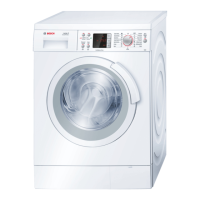
